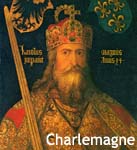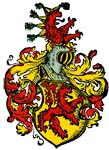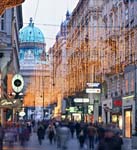The first to come were the Romans; they annexed the area in 150 AD, and made it a province. When the Roman Empire collapsed, Bavarians and Slavic tribes moved into the central and eastern areas.
 Charlemagne, the King of the Franks and Emperor of the Romans, conquered these lands in 788 AD. He encouraged colonization and introduced Christianity to the masses.
Charlemagne, the King of the Franks and Emperor of the Romans, conquered these lands in 788 AD. He encouraged colonization and introduced Christianity to the masses. Over the next few centuries a long series of rulers took charge and overseeing duchies (ruled by a duke or duchess) were established. Most faded into the obscure pages of history, except the powerful Habsburg dynasty.
The House of Habsburg became one of the most important aristocratic royal houses of Europe, best known for being the origin of all of the formally elected Holy Roman Emperors between 1438 and 1740, as well as rulers of the Austrian Empire and Spanish Empire, as well as several other countries
The Habsburgs expanded and acquired additional crowns and lands through marriage, physical force and war, and in varied alliances and forms (especially with Hungary) ruled Austria for some 600 years from Vienna.
And then in 1914, Franz Ferdinand, the Archduke of Austria was assassinated in Sarajevo. His assassination caused Austria-Hungary's declaration of war againstSerbia. This brought Germany and other countries into the conflict, and World War I began.
By war's end, over one million Austro-Hungarian soldiers were dead and some large European powers (including Germany and Russia) had lost vast tracts of land, and were militarily and politically defeated by the allies.
 In 1918 the first Republic of Austria was established, ending the 640-year old Habsburg dynasty. The young republic quickly suffered massive inflation, unemployment, and near economic collapse.
In 1918 the first Republic of Austria was established, ending the 640-year old Habsburg dynasty. The young republic quickly suffered massive inflation, unemployment, and near economic collapse.In 1933, the weak coalition government between the Christian-Social and the Social-Democratic parties gave way when Engelbert Dollfuss became Chancellor in 1932; his main mission was to tackle the problems caused by the economic depression sweeping across the country. In May of 1934, Doffluss declared martial law to protect Austria from Hitler, so Hitler had Dollfuss assassinated in a Nazi coup attempt. His successor, Kurt Schuschnigg, struggled hard to keep Austria independent, but to no avail.
On March 12, 1938, German troops marched into Austria. The country ceased to exist as an independent state as it was incorporated into Hitler's German Reich.
Jewish Austrians were the first target of the Nazi troops; their assets were stripped and nearly 65,000 became victims of the Holocaust. Fortunately about 150,000 Jews survived by fleeing the country.
After the end of World War II in 1945, Austria was restored to its 1937 borders and divided and governed by the victoriousAmerican, British, French and Soviet allies.
On 15 May 1955, after years of tensions and independence talks which lasted for years, Austria regained its full independence by signing the Austrian State Treaty with the Four Occupying Powers.
On October 26, 1955, the Austrian Federal Assembly passed a constitutional article in which "Austria declares of her own free will her perpetual neutrality." It has slightly flexed on that assertion over the years, but still does not allow foreign military bases within its borders.
Because of its location near the "Iron Curtain", Austria soon developed into a nerve center between the West and the East. After the 1956 Hungarian Revolution and the 1968 Prague Spring Invasion, Austria grants asylum to the refugees of those conflicts.
Today, Austria is the host country of many international organizations (UNO, OPEC) as well as host of many important conference and summit meetings. After the 'Iron Curtain fell' in 1989/90, Austria became a member of the European Union in 1995.
 Austria is today one of the continent's most influential countries in both economic and political issues, and over the last fifty years it has transformed itself into a major tourism destination.
Austria is today one of the continent's most influential countries in both economic and political issues, and over the last fifty years it has transformed itself into a major tourism destination. And it is certainly safe to say that no one country can match the musical resume of Austria. It's the homeland of legendary composers like Brahms, Haydn, Mahler, Mozart, Schubert and the Strausses - both father and son. Also, German-born Ludwig van Beethoven lived in Vienna for most of his adult life.
The biography of Austria includes the Viennese Waltz, Vienna Boys Choir and dancing Lipizzaner horses, and when combined with an abundance of natural beauty, cosmopolitan and historic cities, the Danube River Valley, classical music festivals, and of course - world class Alpine skiing and resorts, Austria paints a very pleasant picture, indeed.
No comments:
Post a Comment